Amanita constricta — Constricted grisette
Odour: Not distinctive.
Cap: 5–15 cm in diameter, at first convex, then expanding to become flat, sometimes with a small bump in the centre. The colour is grey to brownish grey, often with darker streaks. The surface is viscid when moist. The margin of the cap has distinct and strong grooves, up to 1.5 cm long. A felt-like patch of white or light grey tissue from the universal veil sometimes remains on the cap surface (see 'Additional image').
Gills: Rather crowded, narrowly attached to the top of the stem when young, and then breaking free. The colour is white at first, changing to grey. The edge is grey as well.
Stem: 8–16 cm long x 1–3 cm wide, cylindrical or gradually thickening towards base. Surface white and silky, often covered with flat pieces of grey material. Hollow.
Ring or veil: No ring on the stem.
Cup (volva): The tight cup at the base of the stem is constricted to a narrow sleeve before expanding with a wide flaring margin. Often greyish on the outside. The constriction gives the species its common name.
Spores: 9–13 x 8–11 µm, white, smooth, not reacting with iodine solutions.
Habitat: On the ground with western hemlock (Tsuga heterophylla), Douglas fir (Pseudotsuga menziesii) and fir (Abies spp.) in BC and Pacific northwest, commonly with oak (Quercus spp.) in California1. Ectomycorrhizal.
Geographic distribution: Widespread in coastal and montane forests in western North America, from BC to California.
Treatment: Contact your regional Poison Control Centre if you or someone you know is ill after eating grisettes. Poison centres provide free, expert medical advice 24 hours a day, seven days a week. If possible, save the mushrooms or some of the leftover food containing the mushrooms to help confirm identification.
Poison Control:
British Columbia: 604-682-5050 or 1-800-567-8911.
United States (WA, OR, ID): 1-800-222-1222.

